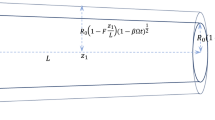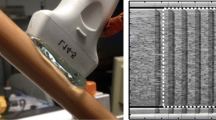Abstract
A uniform, frictional elastic tube terminating in a pure resistor (model A), was compared with a uniform, frictionless elastic tube, terminating in a first-order low-pass filter load (model B). The aim was to address an identifiability problem in uniqueness of parameter estimates and to evaluate the physiological meaning of tube-length estimates obtained from these models applied to the descending aortic circulation. Measurements of high descending aortic pressure and flow were taken from three anaesthetized, open-chest dogs and used to estimate the model parameters. A simultaneous measurement of terminal aortic pressure was used to estimate the foot-to-foot pulse wave velocity. A flow-fitting procedure yielded a multiplicity of equivalent solutions for the wave transit time across the transmission tubes (\({\tau }_{ai}\) for model A and \({\tau }_{bi}\) for model B, \(i = 0,1,2,...,N,...\) and the related tube-lengths \(d_{ai}\) and \(d_{bi}\) respectively. The tube length represents the distance to an effective reflection site (effective length) of the descending aortic circulation. Assuming that this length should be no longer than the dimensions of the body, the lowest estimates (i=0) of wave transit time and tube length (average ±SE: \({\tau }_{ao} = 85.7 \pm 10.8{ms}\) and \(d_{ao} = 53.4 \pm 3.7 {cm}\) for model A; \({\tau }_{bo} = 46.6 \pm 6.7 {ms}\) and \(d_{bo} = 29.1 \pm 3.5{cm}\) for model B) were identifiable as unique and acceptable solutions. Model A located the effective reflection site a few centimeters below the terminal aortic region. This location is inconsistent with the use of a pure resistor as a tube's terminal load. Further, relatively high estimates of longitudinal frictional losses violated the assumption of small losses across the transmission path and yielded an unphysiological mean-pressure drop of 7.1\(\pm\)2.3mm Hg. The estimates of \(d_{bo}\) provided by model B located the effective reflection site near the origin of the renal arteries. The model-predicted pressure wave at this location approximated the measured pressure. Thus, model B represents a significant improvement over model A as a tool to infer wave travel and reflection in the descending aortic circulation. © 2000 Biomedical Engineering Society.
PAC00: 8719Uv, 4760+i
Similar content being viewed by others
REFERENCES
Bard, Y. Nonlinear Parameter Estimation. New York: Aca-demic, 1974.
Bellman, R., and K. J. Åström. On structural identifiability. Math. Biosci. 7:329–339, 1970.
Berger, D. S., J. K.-J. Li, W. K. Laskey, and A. Noorder-graaf. Repeated reflection of waves in the systemic arterial system. Am. J. Physiol. 264 (Heart Circ. Physiol.33): H269-H281, 1993.
Brown, R. F., and K. R. Godfrey. Problem of determinacy in compartmental modeling with application to bilirubin kinet-ics. Math. Biosci. 40:205–224, 1978.
Burattini, R. Reduced models of the systemic arterial circu-lation. In: Vascular Dynamics: Physiological Perspectives, edited by N. Westerhof and D. R. Gross. New York: Plenum, 1989, pp. 69–85.
Burattini, R., and K. B. Campbell. Modified asymmetric T-tube-model to infer arterial wave reflection at the aortic root. IEEE Trans. Biomed. Eng. 36:805–814, 1989.
Burattini, R., and K. B. Campbell. Effective distributed com-pliance of the canine descending aorta estimated by modified T-tube model. Am. J. Physiol. 264 (Heart Circ. Physiol. 33): H1977-H1987, 1993.
Burattini, R., and S. Di Carlo. Effective length of the arterial circulation determined in the dog by aid of a model of the systemic input impedance. IEEE Trans. Biomed. Eng. 35:53–61, 1988.
Burattini, R., S. Fioretti, and L. Jetto. A simple algorithm for defining the mean cardiac cycle of aortic flow and pressure during steady state. Comput. Biomed. Res. 18:303–312, 1985.
Burattini, R., R. Fogliardi, and K. B. Campbell. Lumped model of terminal aortic impedance in the dog. Ann. Biomed. Eng. 22:381–391, 1994.
Burattini, R., G. G. Knowlen, and K. B. Campbell. Two arterial effective reflecting sites may appear as one to the heart. Circ. Res. 68:85–99, 1991.
Campbell, K. B., R. Burattini, D. L. Bell, R. D. Kirkpatrick, and G. G. Knowlen. Time-domain formulation of asymmetric T-tube model of arterial system. Am. J. Physiol. 258 (Heart Circ. Physiol. 27):H1761-H1774, 1990.
Campbell, K. B., L. C. Lee, H. F. Frasch, and A. Noorder-graaf. Pulse reflection sites and effective length of the arterial system. Am. J. Physiol. 256 (Heart Circ. Physiol. 25): H1684-H1689, 1989.
Cobelli, C., and J. J. Di Stefano II. Parameter and structural identifiability concepts and ambiguities: a critical review and analysis. Am. J. Physiol. 239 (Regulatory Integrative Comp. Physiol. 8): R7-R24, 1980.
Fogliardi, R., R. Burattini, and K. B. Campbell. Identification and physiological relevance of an exponentially tapered tube-model of canine descending aortic circulation. Med. Eng. Phys. 19:201–211, 1997.
Latham, R. D., N. Westerhof, P. Sipkema, B. J. Rubal, P. Reuderink, and J. P. Murgo. Regional wave travel and re-flections along the human aorta: a study with six simulta-neous micromanometric pressures. Circulation 72:1257–1269, 1985.
Liu, Z., F. Shen, and F. C. P. Yin. Impedance of arterial system simulated by viscoelastic t tubes terminated in wind-kessels. Am. J. Physiol. 256 (Heart Circ. Physiol. 25): H1087–1099, 1989.
McDonald, D. A. Hemodynamics. Annu. Rev. Physiol. 30:525–556, 1968.
Nichols, W. W., A. P. Avolio, and M. F. O'Rourke. Ascend-ing aortic impedance patterns in the kangaroo: Their expla-nation and relation to pressure wave forms. Circ. Res. 59:247–255, 1986.
Nichols, W. W., and M. F. O'Rourke. McDonald's Blood Flow in Arteries, 3rd ed. London: Edward Arnold, 1990.
O'Rourke, M. F., Mechanical principles in arterial disease. Hypertension (Dallas) 26:2–9, 1995.
O'Rourke, M. F. Towards optimization of wave reflection: therapeutic goal for tomorrow? Clin. Exp. Pharmacol. Physiol. 23 (suppl. 1):S11-S15, 1996.
Papageorgiou, G. L., and N. B. Jones. Wave reflection and hydraulic impedance in the healthy arterial system: a contro-versial subject. Med. Biol. Eng. Comput. 26:237–242, 1988.
Ramo, S., J. R. Whinnery, and T. van Duzer. Fields and Waves in Communication Electronics, 2nd ed. New York: Wiley, 1984.
Roach, M. R., What predisposes the infrarenal abdominal aorta to aneurysms? (abst.) Int. J. Cardiovasc. Med. Sci. 1:65, 1997.
Sipkema, P., and N. Westerhof. Effective length of the arte-rial system. Ann. Biomed. Eng. 3:296–307, 1975.
Shroff, S. G., D. S. Berger, C. Korcarz, R. M. Lang, R. H. Marcus, and D. E. Miller. Physiological relevance of T-tube model parameters with emphasis on arterial compliances. Am. J. Physiol. 269 (Heart Circ. Physiol. 38):H365-H374, 1995.
Taylor, M. G., An approach to an analysis of the arterial pulse wave. I. Oscillations in an attenuating line. Phys. Med. Biol. 1:258–269, 1957.
Taylor, M. G., An approach to an analysis of the arterial pulse wave. II. Fluid oscillations in an elastic pipe. Phys. Med. Biol. 1:321–329, 1957.
Westerhof, N., P. Sipkema, G. C. Van Den Bos, and K. Elzinga. Forward and backward waves in the arterial system. Cardiovasc. Res. 6:648–656, 1972.
Wetterer E., and T. Kenner. Grundlagen der Dynamik des Arterien-Pulses. Berlin: Springer 1968.
Author information
Authors and Affiliations
Rights and permissions
About this article
Cite this article
Burattini, R., Campbell, K.B. Physiological Relevance of Uniform Elastic Tube-Models to Infer Descending Aortic Wave Reflection: A Problem of Identifiability. Annals of Biomedical Engineering 28, 512–523 (2000). https://doi.org/10.1114/1.291
Issue Date:
DOI: https://doi.org/10.1114/1.291




